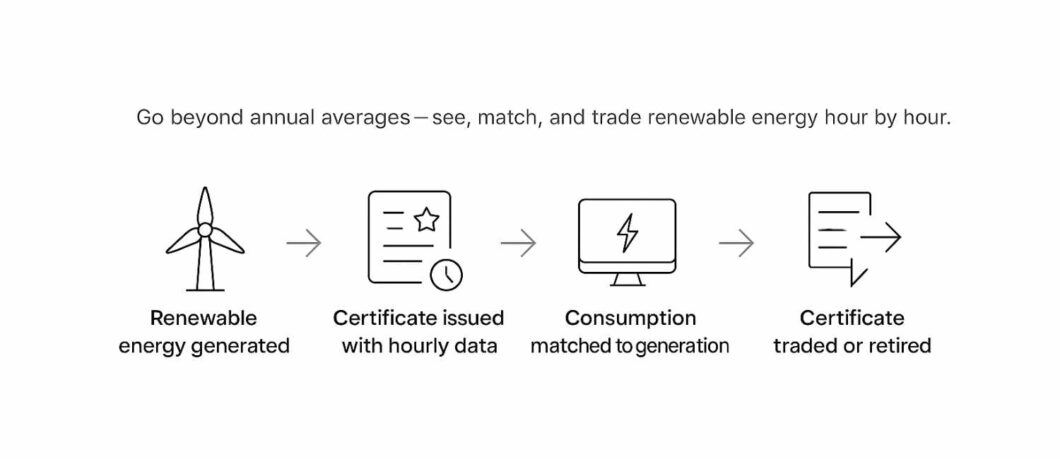Turn clean-energy intent into verifiable, hour-by-hour impact.
Granularity zooms in on *when* and *where* renewable electricity is produced—and how it matches your actual use. That precision builds trust, sharpens price signals, and cuts emissions when it matters most.
What does “granular” mean in energy data?
Granular energy data breaks each megawatt-hour (MWh) into smaller, verifiable slices—most commonly hourly. Each slice can carry attributes like time, location, technology, and even carbon intensity.
It’s the difference between a yearly average and an itemized timeline that mirrors your real consumption.
A monthly phone bill shows one total. An itemized bill shows every call, minute, and time. Granular energy data is the itemized bill for clean electricity.
- Hour-level timestamps tie clean generation to specific consumption hours.
- Location and technology attributes improve system relevance and auditability.
- Optional carbon intensity adds emissions insight—not just MWh counts.
What is a granular certificate?
A granular certificate is an energy attribute certificate (EAC) that includes a fine time stamp (e.g., hour), location, and other attributes for a specific unit of electricity. It’s the same foundation as traditional RECs, GOs, or I-RECs—but with much tighter resolution.
Coarse timeframes, broad claims
- Time: Issued/canceled monthly or annually.
- Claim: “100% renewable this year.”
- Signal: Weak on when clean power is scarce or valuable.
- Audit: Harder to align with real consumption profiles.
Hour-level proof, sharper signals
- Time: Issued and matched hour by hour (or finer).
- Claim: “19:00–20:00 on Jan 15 was matched with wind in Zone A.”
- Signal: Rewards clean power in scarce hours, encouraging storage/flexibility.
- Audit: Traceable to hours, assets, and locations—less room for double claims.
Food label analogy: A label that only says “fruit” (traditional) vs. one that tells you the farm, harvest date, and variety (granular).
What type of granularity are we talking about?
Hourly is the practical default, with 30- or 15-minute intervals in advanced setups. Aligns clean supply with actual consumption and grid conditions.
From country to bidding zone, balancing area, or node/asset level. Proximity and constraints matter for system value and credibility.
Identify the source (wind/solar/hydro/other) and even the specific plant to reflect different profiles and reputational value.
Attach hourly grid emissions or asset-specific avoided emissions to target impact, not just megawatt-hours.
Link to PPAs, tariffs, or supplier products with hour-specific delivery or shaping. Enables 24/7 portfolios and fairer risk allocation.
Why do we need granular certificates?
Shift demand and investment toward clean power in dirty hours (evenings, low-wind periods). Encourages storage, flexible load, and firm clean capacity—reducing reliance on fossil peakers.
Improves disclosure accuracy and time-aligned claims for stronger Scope 2 reporting. Hour stamps simplify audits by matching certificates to metered consumption.
Creates price signals that reflect scarcity across hours and locations. Unlocks new products: 24/7 clean bundles, granular PPAs, and stackable certificates with flexibility or storage.
Reduces greenwashing by replacing vague annual claims with verifiable hourly matching. Builds a common, machine-readable language for buyers, sellers, auditors, and policymakers.
Traffic analogy: Average travel time (traditional) helps, but live traffic (granular) gets you there faster and cleaner.
Quick scenario: monthly vs. hourly matching
A campus buys enough annual RECs to cover its yearly consumption. Nights and winter evenings are still powered by a fossil-heavy grid, yet the paper claim remains “100% renewable (annual).”
The same campus matches each hour with granular certificates, finds an evening shortfall, and contracts storage + wind to fill it. Emissions fall, and spend targets the hours with real system need.
- Procurement: Hour-matched PPAs and retail products pairing generation and storage.
- Operations: Load shifting to hours with abundant clean generation.
- Reporting: Hourly proof for auditors and stakeholders.
- Policy & planning: Better signals for grid investments and interconnections.
- Granular = precise: Move from annual averages to hour-by-hour evidence.
- Better signals: Capital flows to clean power when and where the grid needs it.
- Lower emissions: Target the dirtiest hours to cut the most carbon.
- Stronger trust: Clear, auditable claims stakeholders can verify.
FAQ
Is hourly the only option?
No. Hourly is the practical default today. Some systems use 30-minute or 15-minute intervals—especially where metering and markets already clear at that cadence.
Can I mix granular and traditional certificates?
Yes. Many organizations start with annual or monthly coverage, then layer in granular certificates for high-impact hours (evenings/winter) and scale from there.
Do granular certificates increase costs?
They reallocate spend toward scarce hours. You may pay more for evening coverage but less in abundant midday solar. Over time, better signals can reduce system costs by guiding storage and firm clean supply.
What data do I need?
Your hourly consumption profile, generation attributes (time, location, technology), and—if available—hourly grid emissions. Most modern meters and markets can provide the essentials.
Want help designing a 24/7 strategy?
Contact Jakob
REC Granularity Impact Study
How Time Resolution Affects Carbon Emissions Accounting
Understanding the Challenge
Renewable Energy Certificates (RECs) Tradeable certificates representing the environmental benefits of renewable energy generation, typically issued per MWh of clean energy produced can be purchased at different temporal granularities - from hourly matching to annual bundling. This case study demonstrates how the choice of granularity significantly impacts the accuracy of carbon emissions accounting and the effectiveness of renewable energy procurement strategies.
